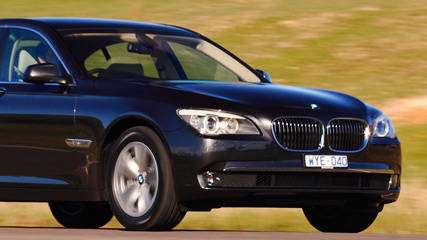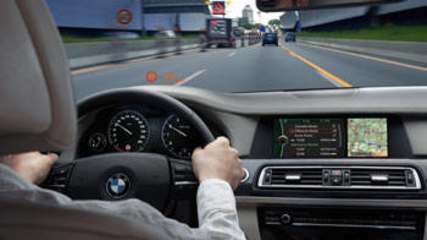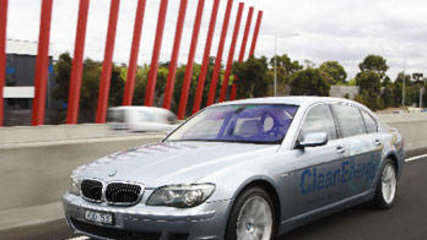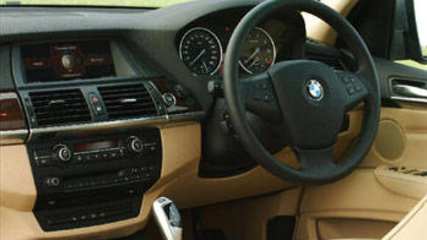BMW 740i 2008 News

BMW 7-Series more efficient
Read the article
By Kevin Hepworth · 19 Jun 2009
...boasting fuel consumption more in line with small four-cylinder cars than its traditional luxo-rivals."This is a car that really redefines how efficient a large luxury car can be," BMW Australia's Toni Andreevski says.The new 730d has an official fuel consumption rating of 7.2L/100km, just 0.2 of a litre above the limit set by the government for cars to benefit from the green car exemption from luxury tax."It is just outside that level at the moment but with almost daily improvements in our efficient dynamics technology I am hopeful that it won't be too long before that level is reached," Andreevski says.In the interim BMW will just have to be satisfied that the 730d is the first car in the upper luxury sedan segment that emits less than 200 grams of CO2 per kilometre, putting out 192 g/km.That measure puts it ahead of the Lexus LS600hL hybrid and diesel competitors in the segment and on a par with a clutch of other four-cylinder cars on the Australian market, such as the manual 1.8-litre Holden Astra CD, the manual 1.6-litre Skoda Roomster and the automatic 1.8-litre Honda Civic VTi."It's not often a luxurious five-seater saloon is compared with smaller four-cylinder cars, but in terms of fuel consumption the 730d demonstrates the remarkable achievement of BMW’s EfficientDynamics programme," says BMW Australia's general manager of marketing, Tom Noble.The 730d's Euro 5 compliant turbocharged all-alloy straight six-cylinder engine produces 180kW and 540Nm, giving the car a 0-100km/h sprint of 7.2 seconds.The 3.0-litre diesel features a third generation common rail direct injection system with piezo injectors and a maximum injection pressure of 1800 bar, variable turbo geometry, diesel particle filter and oxidation catalyst.Standard equipment levels on the 730d are the same as the recently released 740i, including heads-up display, rear view camera, metallic paint, 18-inch light-alloy wheels, Dynamic Driving Control, Brake Energy Regeneration, adaptive headlights, heated and ventilated front seats, sunroof, soft close on all doors, television tuner and voice recognition.

Keeping you up to speed
Read the article
By CarsGuide team · 11 Aug 2008
Their car will do it for them, keeping an electronic eye on the road and giving a constant update on the legal limit.The job is done by a new computerised control system — linking a forward-facing camera to sophisticated software that recognises traditional and electronic speed signs — that flashes the current limit to the dashboard and heads-up display.It is fitted first to the new 7 but is expected to move quickly to other models in the BMW family.Unlike satnav-based systems, the BMW design is not pre-programmed and can react to variable-limit signs and time-sensitive limits such as those in school zones. BMW has no plans to link it to a speed limiter.

BMW keeps eye on speed
Read the article
By Paul Gover · 04 Aug 2008
A car that keeps a constant watch for speed signs, then updates the driver on the latest legal limit, is about to hit the road.It uses a high-tech combination of a forward-facing camera and recognition software that can identify standard speed limit signs _ which use the same basic design around the world _ to create a new benchmark for speed limit warnings.It can also respond instantly to changes in variable speed limits, as well as temporary limits in school zones and roadworks, then flash a warning to the driver.It avoids the potential errors in speed limit warning systems being developed with the same global positioning satellites used for in-car navigation systems.The new system is fitted to the upcoming BMW 7 Series limousine and is expected to cascade quickly through the rest of the Germany luxury brand's models. If the technology is popular, BMW is also likely to license the system to other carmakers.The all-new flagship 7 Series has just been previewed in Europe and the first cars will be delivered in Australia early next year, most likely with the 'Speed Limit Display' system as standard equipment."We are not sure yet of the final specification of the car, but this system looks very interesting. It could be a significant safety bonus," the spokesman for BMW Australia, Toni Andreevski, said yesterday.The system eliminates any doubt about the legal limit and could put an end to police asking the classic "Do you know what the speed limit is here?" when they stop a speeding driver.But BMW has no plans to link the system to any form of automatic speed governor, unlike some of the people behind satnav systems. It says safety systems should always advise the driver, not try to take control."The human brain is still the most complex computer in the world. And the only one that can make moral choices," Andreevski said.The BMW system uses a camera fitted near the interior mirror which looks forward for the telltale combination of a white sign with black numbers, usually inside a red circle. It can read painted metal signs as well as dynamic digital displays.The advantage of the BMW system in the 7 Series is that the limit, and any warning, is flashed into the jetfighter-style heads-up digital display. This projects critical information including a car's speed into the driver's direct eyeline.But it will is also expected to be adapted to other models with a conventional dash and warning lights.

BMW acts to narrow options
Read the article
By Paul Gover · 14 May 2008
The explosive growth of the BMW model range is about to be defused in Australia, with the line-up being trimmed to cut competition and duplication, making it easier for customers in showrooms.The plan is to have only three choices of any individual model, with two petrol engines and one diesel.The current list includes 36 individual models in the 3 Series sedan line-up ... without counting the coupe, convertible or station wagon.“We get a lot of questions about whetherwe have too many models,” BMW Australia managing director Guenther Seemann says.“I think we do have too many.”He believes BMW must cut the choices to streamline business, though he says there will still be all-new models in future — with the X6 four-wheel-drive and M3 sedan up next — asthe German company looks for customers.The work has begun, though there are a dozen individual BMW lines, from the baby 1 Series to the four-wheel-drive X5 and flagship 7 Series, with 50 official engine choices. BMW has 189 individual models on the list.“We've already begun tidying up. The 116i hatch has been removed from the range, there are the manuals in the 3 Series and one of the X3 manuals,” Seemann says.“In the 5 Series range, one of the V8s will go.I believe for each and every model line-up in the future, as we add models, we need two petrol and one diesel variant in each case. No more. We have so many different model lines, it is not practical or possible to display them all in a showroom.”He says it will take time to get things sorted, partly because there are so many models.“It will happen in the next two years. Globally, there are five petrol and five diesel engine choices. And that is just in the 3 Series range,” Seemann says. But there is definitely space for some additions, like the four-door M3 sedan.“We will bring the four-door version, but I do not know at what price. We have to price it lower than the M3 two-door.”

BMW line-up sliced
Read the article
By Paul Gover · 09 May 2008
The explosive growth of the BMW model range is about to be defused in Australia. The line-up is being trimmed to cut competition and duplication, making it easier for customers in showrooms.The plan is to have only three choices of any individual model, with two petrol engines and one diesel. The current list includes 36 individual models in the 3 Series sedan line-up . . . without counting the coupe, convertible or station wagon.“We get a lot of questions about whether we have too many models. I think we do have too many,” BMW Australia managing director Guenther Seemann says.He believes BMW must cut the choices to streamline business, though he says there will still be all-new models in future — with the X6 four-wheel drive and M3 sedan up next — as the German company looks for customers.The work has begun, though there are a dozen individual BMW lines, from the baby 1 Series to the four-wheel-drive X5 and flagship 7-Series, with 50 official engine choices. BMW has 189 individual models on the list.“We've already begun tidying up. The 116i hatch has been removed from the range, there are the manuals in the 3 Series and one of the X3 manuals,” Seeman says.“In the 5 Series range, one of the V8s will go. I believe for each and every model line-up in the future, as we add models, we need two petrol and one diesel variant in each case. No more. We have so many different model lines, it is not practical or possible to display them all in a showroom.He says it will take time to get things sorted, partly because there are so many models.“It will happen in the next two years. Globally, there are five petrol and five diesel engine choices. And that is just in the 3 Series range,” he says.But there is definitely space for some additions, like the four-door M3 sedan.“We are starting the business case. It looks good, I must say,” he says.“We will bring the four-door version, but I do not know at what price. We always follow the normal BMW pattern, where a two-door is more expensive than a four-door. We have to price it lower than the M3 two-door.”

How safe are your airbags?
Read the article
By Brendan Quirk · 16 Apr 2008
If a minor collision sets off all 12 airbags in a 7 Series BMW it could well be written off.Not because of the crash damage but because of the cost of replacing the airbag and seatbelt systems.An Airbag Mobile Reset Service spokesman said the cost of replacing the airbags, the damaged trim and replacing the pre-tension seatbelts on a 7 Series could easily amount between $30,000 and $40,000. “I know of BMWs in Sydney that have been written off because of this cost,” the spokesman said.Airbags are in the news as Australian road-safety campaigns are expanded, but British road safety group, the Guild of Experienced Motorists (GEM), says many people had no idea what happens when airbags deploy or the dangers the bags pose if occupants are unaware of their presence or operation.GEM Motoring Assist says the airbag is a great safety feature and used in conjunction with a seatbelt can often prevent serious injury. But GEM boss David Williams says unless people have experience of the quick-inflating devices, drivers and passengers could panic in a crash.GEM member Matt Day described his first experience of an airbag deploying when he and his wife were involved in a crash.“We were thankful for the extremely fast deployment of the airbags,” Day said. “They seem to have deflated again before I realised they had inflated. What's more, the seatbelts did their job and we didn't get thrown forward.”Day said that when the airbags inflated his car filled with smoke from the mini-explosion, which was necessary to deploy them.“I could sense the car filling rapidly with smoke and my initial reaction was to get out. I screamed at my wife to get out, too.”Day's reaction is typical but based on a lack of knowledge.The airbags are inflated by a small explosion and white smoke or fine powder often fills the car because the airbags have a big hole in the base to allow gases to escape.“The airbag has inflated and is already letting the air out of the big hole usually before the driver or passenger has hit them,” the AMRS spokesman says. “At the same time in most modern cars an explosive charge has gone off down by the seat where the seatbelt is mounted at the base of the seat. This pulls the seatbelt tight. So there can be lots of noise and the smell of burning which often frightens people.”Airbag Mobile Reset Service website warns of airbag dangers.“Airbags inflate in a fraction of a second and with great force. This means if the front-seat occupants of the car are not properly seated and strapped in with seatbelts or are obstructing an airbag compartment with part of their body, they may be injured. There have been reports in the US of children sitting in the front seat or lying in a rear-facing child restraint mounted in the front seat being crushed to death by airbags in low-speed accidents, which they might have otherwise survived."“According to the NSW Roads and Traffic Authority, it is common practice to carry small children in the front seat in the US and Europe. In Australia they're generally in the back because our child restraints usually can't be fitted in the front seat. As long as this doesn't change we shouldn't have the same problem with children being injured."“However, Australian adults still need to be cautious — there have been reports in the US of airbags causing bruises, broken arms, eye damage and adult fatalities."“But they do save lives. Despite the occasional problems, airbags in most cases do prevent serious injury and save lives. For example, General Motors Holden says there has been a 'dramatic' reduction in facial, head and chest injuries to occupants of airbag-equipped Commodores involved in accidents.“The US-based Insurance Institute for Highway Safety has also compared driver deaths in airbag-equipped cars with cars without airbags. The research found there were 23 per cent fewer deaths in airbag-equipped cars involved in frontal and front-angled crashes.”Have you had any problems with your airbags? Let us know by filling out the bottom field.

Hydrogen help plea
Read the article
By Neil McDonald · 01 Feb 2008
Governments around the world should be doing far more to encourage alternative-powered vehicles, says a BMW expert in hydrogen technology.BMW's director of clean energy, Jochen Schmalholz, believes more help is needed to push research and development and to increase the showroom appeal of alternative-powered vehicles.The top-level BMW engineer has just been spruiking BMW's hydrogen message in Melbourne, where the company displayed four hydrogen-powered 7 Series sedans. BMW has built 100 hydrogen-powered 7 Series for research and global promotion, and to push hydrogen as a viable fuel alternative.Schmalholz says tax breaks or other incentives are not new.“It has been done before around the world when we changed from regular petrol to lead-free petrol,” he says.But he says many governments are not aware of future technologies and some are concentrating only on short-term goals.“Basically, they are short-term focused to the next election,” Schmalholz says.“They don't really think about the future."“Even for BMW, we started 30 years ago on this project, knowing it's another 20 to 30 years before we see these cars. But we were convinced that if we didn't we would be out of business.”Schmalholz is encouraged after a meeting with the Federal Minister for Climate Change and Water, Senator Penny Wong, that emission trading and future transport issues are high on the Australian government's agenda.BMW has spent millions developing the hydrogen-fuelled cars even though the first mass-produced cars are not expected to be on roads until about 2040.It has received no monetary assistance from the German government to help its research.Each 7 Series uses a direct-injection dual-mode 6.0-litre V12 engine, which develops 191kW/390Nm and can run on either petrol or hydrogen.Using only hydrogen, the car has a touring range of 240km and emits two glasses of water every 100km from its 8kg tank of liquid hydrogen.BMW aims to have a mass-produced hydrogen car the size of a 3 and 5 Series that can travel 500km between refills.But hydrogen remains an expensive long-term proposition because of storage and infrastructure requirements. About 80 per cent of the world's hydrogen supply comes from natural gas or oil, Schmalholz says.This means CO2 emissions are produced, offset by the fact that CO2 emissions are reduced through the use of hydrogen as a power source for vehicles.The stainless-steel tank containing the hydrogen also needs to be super insulated to keep the contents at -250C.The benefits of hydrogen are obvious, with only water vapour and air coming out of the exhaust pipe cleaner than the air we breathe.It also uses the existing internal combustion engine.Honda, Toyota and Mercedes-Benz are also researching applications of hydrogen as fuel.Governments are short-term focused to the next election. They don't think about the future, BMW's director clean energy, Jochen Schmalholz says.

What 'iDrive makeover'
Read the article
By Karla Pincott · 10 Jan 2008
The complex iDrive system in BMW cars may be getting a revamp by Apple.Since it was launched, the iDrive which houses the cluster of navigation, vehicle information, entertainment and communication controls has been widely condemned as being too complicated and hard to use.Rumours doing the rounds are hinting that BMW is chatting to Apple about a redesign, which might be seen first in the next 7-Series. This follows BMW's announcement this year that it would be the first carmaker to have compatibility with Apple's revolutionary iPhone, which uses nanotechnology for a `touch and pinch' screen interface.However the current iDrive system uses Microsoft software for the telematics, so any changeover to an Apple user interface would likely mean a significant re-engineering program.There has been some suggestion that BMW may simply add the `click-wheel' interface seen on later Apple iPods. But while it's the iPod that has made the click wheel ubiquitous, the interface is used by other companies and is not copyrighted by Apple.In fact, Apple itself faced a copyright lawsuit over the click wheel, with British touch sensor chip company Quantum Research Group filing a claim of patent infringement of the company's capacitive sensing technology it claims is used in the wheel.However BMW Australia spokesman Toni Andreevski says he has not seen any official information about the iDrive being redesigned.“I haven't seen anything through BMW on the Apple stuff,” Andreevski says.“I've seen some rumours, but I don't know how genuine they are. But iDrive will continue to be evolved, as we've seen with the recent launch of the very useful `favourite' buttons, and at this stage our customers are happy with the current set-up so there are no plans for major changes.”

There's an avalanche of German luxury on the way
Read the article
By Paul Pottinger · 26 Jun 2007
The brain's logical left lobe would probably dictate a highly specced and relentlessly reliable Japanese model.The riotous right side might love something Latin.Call it a feeling from the gut, then, but some part of you simply must have a badge featuring either a blue-and-white roundel or a three-pointed star. Or even four rings.Never mind that they're almost always over-priced for the package on offer and about as suited to Australian roads as Beethoven to a Shannon Noll audience, but we seem unable to get enough of the wares offered by BMW, Mercedes-Benz and increasingly, Audi.Which is just as well, given that there will be releases from all three marques this month.June marks the opening salvo of a second-half-of-'07 product offensive on three fronts, using every type of armament at the makers' disposal; from diesel hatchbacks through high-end sports machines to ferociously powerful SUVs.In popular terms, the most significant of these is the new-generation Mercedes-Benz C-Class.The W204 series arrives next month with the four-cylinder Kompressors, V6 petrols and two diesel models.A six-cylinder purchase gets you a seven-speed auto transmission, but the fours make do with five speeds.Hard to say where the pricing will sit at this point, though a slight increase on the current model is possible.A more dynamic driving experience is promised, something to which Merc's Agility Control system is central.Indications from the world launch in Spain are that Mercedes' best-selling product has achieved that stated aim within a veneer of sexier, or slightly less conservative, styling.Of course, this launch took place on European roads, not our Australian tarmacs.The vastly improved new Smart fortwo coupe and cabrio arrive in November, to the delight of at least several hundred people.Between then and now, though, comes something altogether more potent.The ML 500 SUV and R 500 MPV cop a 285kW V8, up 60kW on the hardly deficient current version.These should be among us by early October, along with a 320 CDI model of the S-Class, marrying the marque's superb V6 diesel to its luxury limo.BMW fires two shots; one small-calibre, the other medium, from its locker this month.The One Series evokes mixed reactions but a coupe version is due next year and the five-door hatch receives a new four-cylinder diesel engine, minor inside and out facelifts and mechanical upgrades for greater efficiency.The updated Five Series gets new front and rear bumpers, restyled headlights and tail lights with LED.Better yet, it gets a quicker-shifting six-speed automatic tranny, controlled by the electronic gear selector from the X5 off-roader.The 530i Sedan and Touring gain 10kW of power and 15Nm of torque for totals of 200kW and 315Nm, and smarter 0-100km/h times throughout the range.New Seven Series Executive and Sport models arrive next month, but the lip-smacking becomes deafening in the fourth quarter with the new M3 coupe.Forsaking the straight six, this fourth-gen M3 packs an all-new, 309kW/400Nm V8 of four litres.Driven by the rear wheels (of course) through a six-speed-manual, it promises acceleration to 100km/h in only 4.8sec.The M3 is billed as the first production vehicle in its segment to feature a carbon fibre-reinforced roof; an innovation to save weight and lower the centre of gravity.Audi's counter-offensive begins next week with the local release of its S3 hot hatch and a ragtop version of the TT. Expected to outsell its hard-hat cousin, the open TT dispenses with the coupe's comedy back pews, increasing its boot space.Nor does it command an unreasonable premium over the coupe, with the front-drive 2.0 TFSI starting at $77,500, the V6 quattro at $92,900. But the roadster's sole transmission is the manual-matic S-tronic.No such pandering for the S3, which unites a creamy six-speed manual with quattro. And how all-wheel drive is needed.Hosting a rebuilt and “up-gunned” version of the VW Golf GTI's two-litre, direct-injection turbo four, the S3 can call upon a V6-daunting 188kW and 330Nm. At an estimated $65,000, it will come in cheaper than the top-whack, but decidedly lesser, A3.If the S3 is a genuine Q-car (there being little to visually distinguish it from Audi's milder hatches), there's no denying the latest Q7.Due in November and priced from $124,000, the already imposing SUV packs a turbine-like 4.2 TDI, a turbo diesel dreadnought that generates 240kW at 3750rpm and a warping 760Nm between 1800 and 2500rpm.As Wagnerian as it is, its thunder may be stolen as early as October. Not so much by the A5 and S5 (touring coupes with Walter da Silva style and nice engine notes) but the R8 sports car.Though it will be priced in the region of $270,000, you won't be able to buy one for ages, even if you have the readies.Audi has been taking orders for the instantly desirable, mid-engined V8 quattro two-seater since it was unveiled at last year's Sydney Motor Show.That car evokes a profound response from a region lower even than the gut.




